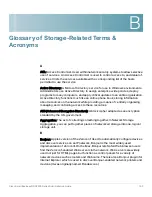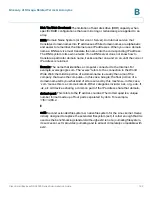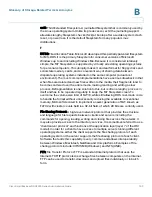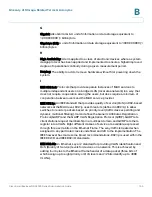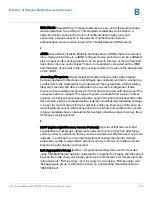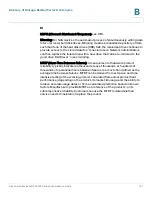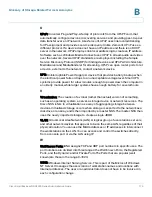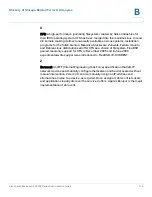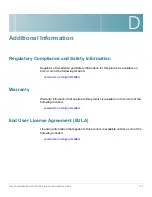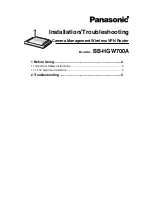
Glossary of Storage-Related Terms & Acronyms
Cisco Small Business NSS2000 Series Administration Guide
174
B
U
UPnP: Universal Plug and Play. A family of protocols from the UPnP Forum that
automatically configure devices, discovering services and providing peer-to-peer
data transfer over an IP network. Like Zeroconf, UPnP uses link-local addressing
for IP assignment and provides service discovery. Unlike Zeroconf, UPnP uses a
different protocol. If a device does not have an IP address and there is no DHCP
server in the network, UPnP employs link-local addressing to create an IP address.
Software such as Windows Media Connect uses UPnP to stream audio and video
over the network. Several UPnP standards are employed including the Simple
Service Discovery Protocol (SSDP) for finding devices and UPnP AV Architecture,
MediaServer and MediaRenderer for streaming. UPnP can open router ports to let
a device, external to the network, contact a network device.
UPS: Uninterruptible Power Supply. A device that provides battery backup when
the electrical power fails or drops to an unacceptable voltage level. Small UPS
systems provide power for a few minutes; enough to power down the computer in
an orderly manner, while larger systems have enough battery for several hours.
V
Virtualization: The creation of a virtual (rather than actual) version of something,
such as an operating system, a server, a storage device or network resources. The
Cisco NSS refers to virtualization as a way of aggregating storage between
devices. Virtualized storage occurs when storage is exported to the network as a
disk drive or an array and is then imported by a master NSS. The master NSS then
uses the newly imported storage to create a single JBOD.
VLAN: Virtual Local Area Network (LAN). A logical group of user stations, servers,
and other network devices that appear to be on the same LAN, regardless of their
physical location. You can use the MAC addresses or IP addresses to interconnect
the workstations on the LAN. You can access and control the switches directly
from a console port or via the LAN using IP.
W
Well Known Ports: IANA assigns TCP and UDP port numbers to specific uses. The
port numbers are divided into three ranges: the Well Known Ports, the Registered
Ports, and the Dynamic and/or Private Ports.The Ports that are popular (well
known) are those in the range 0–1023.
WINS: Windows Internet Naming Service. This is part of the Microsoft Windows
NT Server. It manages the association of workstation names and locations with
Internet addresses. The user or an administrator does not have to be involved in
each configuration change.

